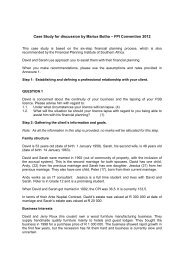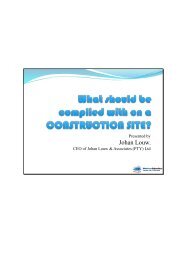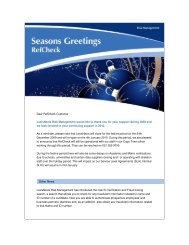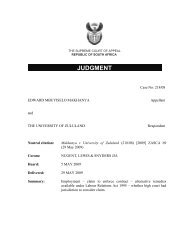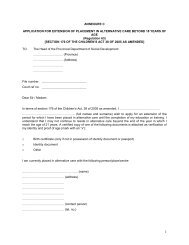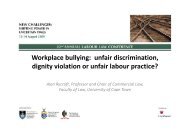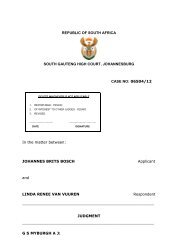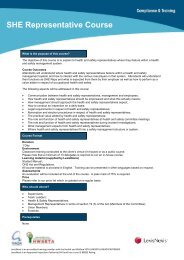Matthew Ncube OSH Presentation - LexisNexis South Africa
Matthew Ncube OSH Presentation - LexisNexis South Africa
Matthew Ncube OSH Presentation - LexisNexis South Africa
- No tags were found...
You also want an ePaper? Increase the reach of your titles
YUMPU automatically turns print PDFs into web optimized ePapers that Google loves.
Challenges for SHE Managementin Workplaces:“Mining Sector”SHE Manager’s PerspectivePresentedby<strong>Matthew</strong> M <strong>Ncube</strong>Senior Consultant /SpecialistOccupational Safety and HealthLEXIS NEXUS <strong>OSH</strong> CONFERENCE9/13/20111
BRIEF ON PRESENTER• Title: Senior Consultant and Specialist for <strong>OSH</strong> (ILO)• Senior Consultant for SHE with IRCA• Director Global Risk Support Group• National Executive Director for <strong>OSH</strong>RPD• Chairperson of SADC Technical Sub- Committee for <strong>OSH</strong> in theEmployment Labour Sector• Senior SHE Manager for various Organizations• UK Educated in Sciences and Occupational Hygiene(Occupational Safety and Health)• Organizing Board Member for ICOH Conference in <strong>Africa</strong>• Member of Board of Health Sciences with ICHE (UZ)9/13/20112
Scope of presentation• Objectives of the presentation• Introduction and Background;• Essential Fundamentals for SHE Management;• Aspects of Challenges for SHE Management;• Elements of challenges versus Best Practice• Key aspects for assurance of effectiveness andefficiency• Recommendations;• Way Forward;• Conclusion.9/13/20113
Introduction and Background• Why Mining Sector?• International Perspective from ILO and WHO;• Definition of the elements of SHE Managementsystems;• Key functions of the SHE management systems;• Three-tier and four tier scope of requiredmanagement systems in the world of work;• Scientific information drivers for the SHEmanagement systems;• Framework for the foundation of SHEmanagement systems in the world of work.9/13/20115
ILO Instruments:12Conventions and Recommendations: NationallyNational Act;Specific Regulations; ACOP etcORGANIZATIONAL REQUIREMENTSJohn DoeManagementjohnny@visualbee.comSystemsjohnny@visualbee.comOperational StandardsOperational ProceduresMinimumrequirements3VEHICLE FOR IMPLEMENTATION:Social DialogueManagement LeadershipStrategic PlanningImplementation and Reviews9/13/2011 6
Three Tier FocusPeopleWorkplace/WorkingConditionsEnvironment9/13/20117
SHE INTEGRATED MANAGEMENT STRATEGICAPPROACHPEOPLEWORKPLACECONDITIONSENVIRONMENTCOMMUNITYENVIRONMENT9/13/20118
Key Focal Aspects for <strong>OSH</strong>COMMUNITY ENVIRONMENTWORKING CONDITONSWORKERWORKING ENVIRONMENTCOMMUNITY ENVIRONMENT9/13/20119
Essential Fundamentalsfor SHE Management• Driven by Values and Culture;• People-centred;• Contribution to national economic growth;• Enhancement of business optimization;• Proactive thrust;• Foresight; Knowledge, Skill and Education• Vision and Roadmap9/13/201110
KNOWLEDGEEXPERIENCESKILL9/13/201111
Acknowledged Challenges• Traditional approach;• Perceptions of the role and functions of SHE inthe workplace;• National Leadership and Organization;• Lack of coherent integrated approach;• Legalistic approach;• Definition of SHE Professionals and Elements;• Human Resources for SHE;• Fragmented Implementation of managementsystems.9/13/201112
Safety isCommon Sense:Anyone Can Do ItInadequatelyDefinedAnd ImplementedProgrammesInadequate RiskManagementSystemsTRADITIONALAPPROACHLegalisticApproach: CreatePortfolio of Evidence:Prosecution9/13/2011Inadequate FocusOn OccupationalHygiene and HealthElementsGreater Focus onLagging Indicators:Injuries: post events13
Challenges versusBest PracticeElement Challenge Recommended Best PracticeNationalFactors9/13/2011Pronounced nationalleadership is notclearly enunciatedThe legal frameworkfor SHE functionsfalls within differentlegal statutorybodies creating afragmented approachEnforcement of thelegal requirements isskewed towardspunitive reactivethrustNational Policy is essential to definethe roadmap for workplaces toadopt.National laws pertaining to SHErequirements need to berationalised into an integratednational approach to simplify andenhance effective complianceEnforcement of legal requirementsneeds to consider processoptimisation thrust to enhancebusiness performance14
Challenges versus Best PracticeEnterpriseLevelPrevalent traditionalregressive approach thatviews SHE as a negativecost on businessVery ambiguousperception of thefunctional role of SHE.Viewed as not part ofcore businessResources for SHEmanagement tendto be very poor andtypical target for budgetcuts when hard timesoccurInvestment in SHE yields benefits forexcelling performance of business througheffective management of risksProper perception of the proactive role ofSHE as part of the integrated core businesselement to accord it its proper statusHR aspects for SHE need to be properlyassessed and determined through effectivedetermination of professional/technicalresources for effective service delivery9/13/201115
EnterpriseLevel9/13/2011Challenges versus Best PracticeRecruitment of SHEProfessionals is not basedon properly definedtechnical knowledge andskills. The SHE trainingprograms are not properlystructured and definedOnly a limited number ofcompanies implement SHEmanagement throughspecifically designedsystemsRisk based approach is notwidely applied in theWorld of WorkSHE is a scientific basedsubject that needsappropriately educated andtrained people. The one sizefits all approach has notworked and will never work.Best practice requires that SHEmanagement is implementedthrough specifically developedand implementedmanagement systems.The Risk based managementapproach for SHE systemsshould be standardised16
ROLE OF EDUCATION AND TRAININGCAPACITYBUILDING FORPROFESSIONALS&PRACTITIONERSTRAINING OFWORKERS ONSAFE BEHAVIOURAND ATTITUDESTRAINING OFOCCUPATIONALHEALTHPRACTITIONERSTRAINING OFMANAGEMENT ONIMPLEMENTATION OFSHE MANAGEMENTSYSTEMS<strong>OSH</strong>EDUCATION& TRAININGCAPACITY BUILDINGFOR IMPLEMENTATIONOF EFFECTIVEPROGRAMMESNATIONALEDUCATION OF <strong>OSH</strong>PROFESSIONALSFROMGOVERNMENTDEPARTMENTSTRAINING ON <strong>OSH</strong>PROGRAMMEELEMENTSCERTIFIEDNATIONALEDUCATIONIN <strong>OSH</strong>9/13/2011TRAINING AND EDUCATIONON <strong>OSH</strong>MANAGEMENT SYSTEMSTRAINING ON <strong>OSH</strong>LEGALPROVISIONS17
IF YOU THINK TRAINING IS EXPENSIVETHEN TRY IGNORANCE9/13/201118
Challenges versus Best PracticeEnterpriseLevelSocial dialogue is very weakhence people are givenpositions with weakempowerment.Positions of SHE personnel tendto be pegged lower than otherproduction related functionsclearly creating distorted viewsManagement and employeeinteractive engagement is essentialfor the effective and collectiveownership of SHE initiatives inworkplacesSHE functions are very key fororganizations hence should bepegged at the same level as otherfunctions.9/13/2011SHE functions tend to be“known” by everybody in anorganization hence not properlyrecognized as specializedprofessionOrganizations need to acknowledgethe peculiarity of SHE in theapplication of specific scientific basedprinciples and knowledge.19
Challenges versus Best PracticeArrangement forservice delivery9/13/2011Individual PerformanceAgreement (IPA) system notproperly applied for SHEManagement Performanceevaluation or measurementSHE Managementperformance failures mainlyattributed to SHE personneland department whenincidents occurManagement of Risks as thekey driver for SHEManagement performancenot effectively adopted inorganizationsIPA system should be appliedeffectively and consistently to ensurethat required performance inputsand outputs are properly achieved byall designated personnel in theorganizationSHE Management functions to bedefined focused on professionalscope of providing assistance, adviceand assessments/auditsOrganizations need to adopt theconcept of managing SHE operationalprogrammes based on the RiskManagement approach driven byeffective Risk Assessments20
Challenges versus Best PracticeLeadership/ManagementSupportive initiatives(apparent commitment)effective commitmentversus supportDo not walk the talkTendency to be biasedtowards productionwhen situations ofconflict ariseEffective commitment is essential toensure that required leadership for SHEManagement is providedNeed to live by demonstrated actionsto any enunciated managementcommitmentsTop priority for SHE Managementinterventions to be upheld to avoidtrade offs when risky situations prevail9/13/2011Interference withinvestigations hencedistort the intent andpurposeComprehensive training required formanagement levels on the SHEManagement systems elementsespecially the benefits derived fromtheir implementation21
Challenges versus Best PracticeManagementNot adequately traineddue to pressures forproductiondemonstratinginadequatecommitmentAdequate resources including time needto be allocated to ensure thatcomprehensive training is provided tomanagement on the elements of SHEManagement systems .Inadequateinvolvement in SHEManagement systemsTendency to have abasic simplistic view ofSHE ManagementDevote quality time to carry out keyactivities that demonstrate effectivecommitment (Inspections, VFL, RiskManagement, communication, groupmeetings)Recognize and appreciate unique role ofSHE as a specialised professional function9/13/201122
Benefits of risk management9/13/201123
CHALLENGES VS BESTPRACTICEElement Challenge Recommended Best PracticeSystemsSHE management systems notimplemented with same thrustand discipline as in otherorganizational core functionsSHE Management systems should beapplied consistently to enhance businessperformance of the organization that isintegrated into core operational elementsApplied outside the socialdialogue and humaninteractive processNot utilized effectively andefficiently by nonmanagement employeesEssential to enhance effectiveness andefficiency of SHE Managementperformance through a structuredprocessScope of application should be extendedto all employees on site to enhanceeffective and efficient application toachieve collective ownership9/13/201124
Challenges versus Best PracticeSHE ProfessionalsThe implementation of SHEManagement systems is noteffective due to inadequateeducation and trainingSHE professionals academic andskills training should be clearlydefined for the various levels ofpositionsOvershadowed by otherdepartments because of beingperceived as mere supportfunctionProfessionals to command thesame level of status to ensureSHE services command the samestatus as other core functionsDo not apply SHE managementsystems to implement therequired operationalprogrammes andcomplementary activitiesNeed to consider the properapproach of implementing SHEManagement systems that arerisk based9/13/201125
Challenges versus Best PracticeSHEPersonnel9/13/2011Seek approval from the otherpeer departments throughdoing what is deemed“acceptable”Lack of social dialogue basedon a highly interactiveengagement with all levels ofpersonnel in the organizationHave inadequate information onthe dynamic scientific andtechnical developments due topoor HRD programmesApply principles ofprofessionalism based onethics, honesty, integrity,one team concept andindependenceApply the principles ofsocial dialogue to enhancethe effectiveness andefficiency throughcollective ownershipNeed comprehensiveeducation and training toensure that they developcapacity to contribute tothe HRD strategic planning 26
Challenges versus best practiceElement Challenge Recommended Best PracticeSHEPersonnelViewed as aliens due to notbeing well versed issuesExpeditiously gain comprehensiveknowledge of the organizations’operations, processes activities andlayout to enhance their role in SHEManagementNot well versed on peoplemanagement skills foreffective interaction withmanagement and employeesChallenged on theapplication of the integratedSHE Management systemsAll SHE professionals need training onpeople management skills to enhanceeffective interactive practicesTraining and education modules shouldinclude aspects of the integrated SHEManagement Systems approach9/13/201127
ROLE OF SOCIAL DIALOGUEBenefits:•Collective involvement•Collective ownership•Collective commitment•Cooperation•CollaborationOperational Programmes:•Effective communication•Management/employeeinteraction: VFL•Consultations / LiaisonGovernment:National <strong>OSH</strong>CouncilEmployersOrganizationsILO Strategy &ConventionsWorkersOrganizations9/13/2011 28
Challenges versus Best PracticeElement Challenge Recommended Best PracticeSHEEducationandTrainingAll sorts of varied training andeducation programmes in SHEManagement exist without anyproperly structured processEducation and Training modulesnot well defined or standardisedin terms of various SHEprofessional levels inorganizationsShop Stewards and Safety (SHE)Representatives not effectivelycapacitated to play theirleadership role for employeesProfessional Training and Education inSHE should be defined to ensure thatproper qualifications and servicedelivery are attainedSHE Training needs to be defined interms of recognized andprofessionally certified training.Various training programmes need tobe subject to a training approvalsystem.Shop Stewards and SHERepresentatives need to be properlytrained to enhance their effectiveinvolvement and engagement in theimplementation of systems9/13/201129
Challenges versus best practiceElement Challenge Recommended Best PracticeAwarenessandPromotionInadequate and ineffectivepromotion programmes forawareness to enhance SHEproactive thrustInadequate innovativeincentive schemesPlanned and structured promotionprogrammes need to be developedand implemented to enhanceeffective dissemination ofinformationIncentive schemes need to beproperly established to effectivelyenhance dissemination of SHEinformation for sustained proactiveinterventionsIneffective and inefficientcommunication of SHEinformationStructured communicationprogrammes are essential withclearly defined effective and efficientsupport operational systems9/13/201130
EFFECTIVE COMMUNICATION9/13/201131
SHE MODEL• Organizations need to adopt the modernconcept model of managing SHE systems inthe World of Work.• Organizations need to assess their currentstatus in other words:• Where are we?• What should be done?• Who should do what?• When should it be done?• How should it be done?9/13/201132
9/13/2011 33ASSESSMENT (AUDITING) AND ASSURANCE
MATURITY MODEL – ROAD TO EXCELLENCE9/13/2011 34
INCIDENT CAUSATION MODELBEHAVIOURALASPECTS9/13/2011 35
Summary of <strong>Presentation</strong>• Fundamental framework for SHE Management should beestablished as top priority;• SHE Management is an integral component of core businessperformance in an organization;• SHE Management needs to be implemented through properlydesigned risk based management systems;• SHE Management measures of performance should be basedon proactive parameters;• The role of employees in SHE Management is essential forcollective ownership of all the implemented initiatives.• Effective and efficient SHE Management Systems needproperly trained and educated professionals;• Effective Top Leadership involvement is essential for SHEManagement demonstrated through effective commitment.9/13/201136
CONCLUSION• Strong leaders are critical for sustained structured effective andefficient SHE Management systems• Through what they do and what they choose to focus on,leaders shape the proactive culture that drives effectiveperformance,• Leaders Influence the implementation of effective and efficientsystems and processes that create positive outcomes.• Effective and efficient SHE Management Systems essentially needto be driven from a Risk Management approach,• Collective ownership and cooperation between managementand employees is the essential ingredient for success• The result is world-class safety performancethat drives operational excellence.9/13/201137
CERTAINLY THE FUTURE IS BRIGHT9/13/201138
Comments and Questions9/13/201139
Thank You!!!9/13/201140



